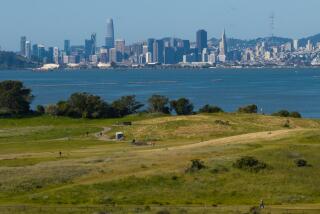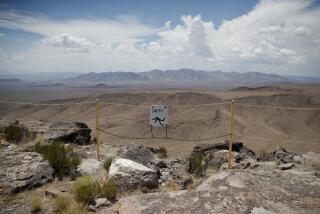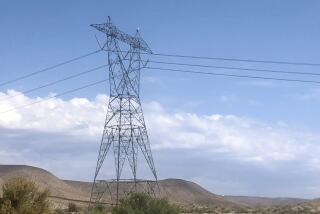Nuclear Waste Dump Foes Call Science Academy Biased : Environment: Two senators and seven members of national body say its panels assessing Ward Valley and Yucca Mountain sites are pro-nuclear power.
- Share via
Officials in California and Nevada opposed to construction of the Ward Valley and Yucca Mountain radioactive waste dumps have questioned the impartiality of the National Academy of Sciences, the country’s oldest and most august scientific body, which has been assessing the safety of the proposed dump sites.
In letters last week to the academy’s president, U.S. Sens. Barbara Boxer (D-Calif.) and Richard H. Bryan (D-Nev.) as well as seven members of the national academy contended that the makeup of panels on nuclear waste sites is weighted heavily in favor of nuclear power interests that have been lobbying for the Ward Valley and Yucca Mountain dump sites.
The senators complained that the academy panels have not given equal opportunity to critics of the proposed waste sites.
“At least 10 members of the panel are or have been employees of or contractors for the Department of Energy in support of DOE’s nuclear activities,” said a report accompanying Boxer’s letter.
“Not a single scientist associated with environmental organizations was included,” said the report, which was written by the Committee to Bridge the Gap, a Los Angeles group that has led the opposition to the Ward Valley dump.
With an academy panel wrapping up its review of the Ward Valley project in the eastern Mojave Desert, opponents are fearful that a favorable assessment by the prestigious body will persuade the Clinton Administration to drop its concerns about Ward Valley and make the federally owned site available for use as a nuclear waste dump.
The proposed waste site near Needles on the Arizona border would accept radioactive waste from nuclear power plants and other industries and bury it in trenches in the desert. Critics argue that there is too great a danger that long-lived waste would leach into the ground water and ultimately into the Colorado River, which is about 20 miles away and a source of drinking water for millions of people.
Last summer, a 17-member National Academy of Sciences panel visited the site, held hearings and began work on an assessment of the geological suitability that is expected to be released within the next several weeks.
Criticism of the academy’s process also has been expressed in another recent letter from three New York legislators concerned about a proposed radioactive waste dump in their state.
Noting the similarity of the complaints from California, Nevada and New York, the seven academy members who wrote a letter cited “a generic problem” with the way proposed waste sites are being assessed.
“It is apparent that the procedures and findings . . . have been weighted against criticisms of current governmental and industrial nuclear policies,” their letter said.
The letter added that 90% of the budget of the academy’s Board on Radioactive Waste Management, which oversees the assessment panels, comes from the U.S. Department of Energy. “This heavy dependence upon such funding may be contributing to a conflict to evaluate prudently proposals of DOE. . . ,” the scientists wrote.
Most of the academy members who signed their names to the letter did so at the behest of Robert Livingston, a professor emeritus of neurosciences at UC San Diego and a past president of Physicians for Social Responsibility, one of the groups opposed to the Ward Valley project.
In reply, academy officials have defended the panels, saying in a letter to Boxer that reviews of the panel members, at the time of their nominations, determined “that none of the members has a conflict of interest that would affect his or her involvement in the study.” The letter added that experts on both sides of the Ward Valley controversy had been given ample opportunity to air their views.
The debate over Ward Valley, Yucca Mountain and other proposed burial sites for nuclear waste poses a dilemma for scientists and policy-makers. On one hand is the challenge of finding permanently safe resting places for some of the world’s most toxic trash. On the other hand is the demand to do something now with the growing inventory of radioactive waste piling up in storerooms, laboratory closets and other temporary storage spaces.
In Nevada, where the state government has long been opposed to a Department of Energy plan to store high-level nuclear waste in Yucca Mountain, officials said they were concerned, based on past experience, that the academy would give short shrift to theories that might detract from Yucca Mountain’s suitability. One of those theories, which has yet to be investigated by the academy, holds that atomic wastes buried deep underground, as they would be in Yucca Mountain, might erupt in a nuclear explosion.
More to Read
Sign up for Essential California
The most important California stories and recommendations in your inbox every morning.
You may occasionally receive promotional content from the Los Angeles Times.










